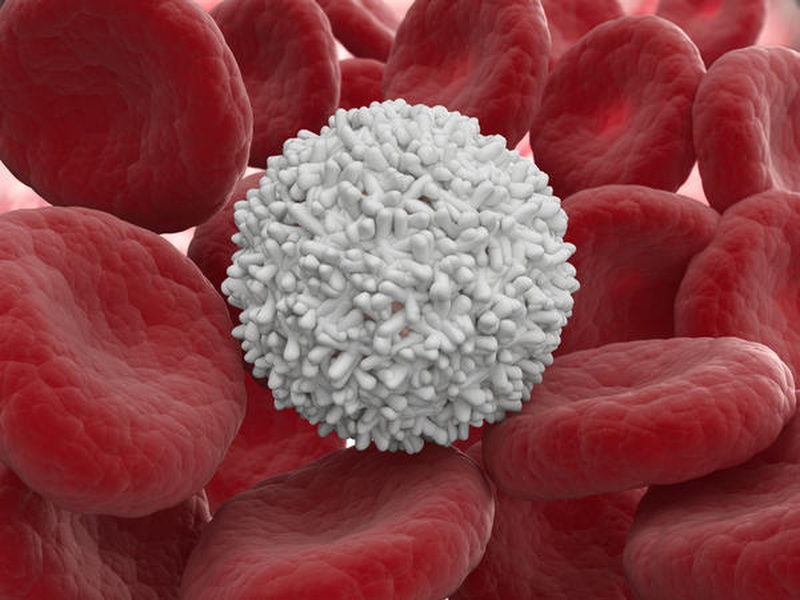Leukocytes are another word for white blood cells or WBCs. These are a crucial part of the immune system as they defend our bodies from infectious diseases and foreign materials. There are five different types of leukocytes in our bodies, each of which is derived from bone marrow’s hematopoietic stem cell. These leukocytes are found in the blood and lymphatic system as they travel to infected organs and tissues, attacking the infection’s cause. There're about 1 percent of white blood cells in an adult's blood.

Functions of Leukocytes
Basophils
Basophils (basophil granulocytes) account for between 0.01 and 0.03 percent white blood cells and specialize in inflammatory reactions, particularly those due to allergies. They work to prevent blood clots and also release histamine which manages blood flow to organs and tissues.
Eosinophils
These white blood cells neutralize parasitic infections as well as protecting the body from allergic reactions, such as hives, asthma, and hay fever. Some of the infections eosinophils defend the body from worms (river blindness, liverfluke, guinea worm, hookworm, tapeworm, and roundworm), chagas disease, sleeping sickness, malaria, giardia, and babesiosis.
Monocytes
This type of leukocytes replenishes components of the immune system, including macrophages (which surround then digest tissue waste and cellular debris) and dendritic cells (which supply and process antigen material for other cells in the immune system). Monocytes travel to infected sites where they separate into dendritic cells or macrophages to start the immune system defense and ingest foreign matter.
Neutrophils
This type of leukocyte defends the body from bacterial infections. Large numbers of neutrophils will charge the bacteria causing the disease, attacking and activating the contaminant in order to neutralize infection. They protect against tetanus, typhoid fever, diphtheria, syphilis, cholera, leprosy, and tuberculosis.
Lymphocyte
A type of lymphocyte is the NK (natural killer) cell, which works to defend the body from tumors, whether they are benign, pre-malignant, or malignant. NK cells work by releasing granules that kill these cells, destroying all cells which are abnormal.
Leukocytes in Urine
Causes of Leukocytes in Urine
It is common to find white blood cells and protein in the urine when pregnant. There may be increased leukocyte counts as well as proteins entering from the vagina. It may be a bladder infection if high levels are persistent.
Kidney infections may increase the number or leukocytes in urine. These infections begin in a person’s urinary tract before spreading to the kidneys. This is more common in those who use catheters or have weak immune systems.
Excess leukocyte secretion may be due to cystitis (inflammation) or bladder infections.
Urinary system blockage can lead to blood in urine (hematuria), because of unwanted foreign bodies within the urinary tract or prostate hypertrophy, bladder or kidney stones, pelvic tumors, or trauma.
Bacteria may also be transferred to a person’s urethra via sexual intercourse, leading to infection and presence of white blood cells.
If you hold your urine too long, your bladder can overstretch and weaken. This may lead to the inability to completely empty the bladder and a bacterial infection.
Treatments for Leukocytes in Urine
Begin by drinking more fluids so the infection flushes out of the system. Even if you are experiencing pain during urination, take steps to avoid dehydration as it will only worsen the problem. Instead, aim to drink at least 2 liters (or 5 large glasses) each day.
In cases where antibiotics are necessary, your doctor will pick one the infection is sensitive to. The antibiotic selected will depend on your medical history and local guidelines as well as any allergies or side effects you’ve previously experienced from antibiotics.
You will take the antibiotics for three to seven days based on the infection severity and a history of diabetes or kidney disease. In some severe cases, intravenous antibiotics are necessary.
Leukocytes in a Stool
Few Leukocytes
In most cases, a lack of leukocytes in a stool sample indicates diarrhea caused by a virus, such as the infectious Norovirus. It is also possible to see no leukocytes in cases of diarrhea and cholera from E. coli or other parasites. If there are red blood cells, but no white blood cells in the stool, then the patient may have amebiasis.
Moderate Leukocytes
Moderate numbers of white blood cells can indicate a pathogenic infection in the digestive tract. Bacillary dysentery, or shigellosis, is one common cause for leukocytes in stools or watery diarrhea and this is typically due to contamination of a feco-oral nature. Symptoms include diarrhea, vomiting, body ache, stomach cramps, and fever.
Many Leukocytes
If there are many leukocytes, this typically indicates a severe infection of the intestinal tract, such as typhoid. In the case of typhoid fever, you will mostly find monocytes in the stool and experience fever as well as abdominal pain. Untreated shigellosis and invasive E. coli infections may also lead to high leukocyte levels. Frequently, a count between moderate and many will lead to a temporary diagnosis of salmonellosis or shigellosis. Gastroenteritis may also be a cause.

View All Comments /Add Comment